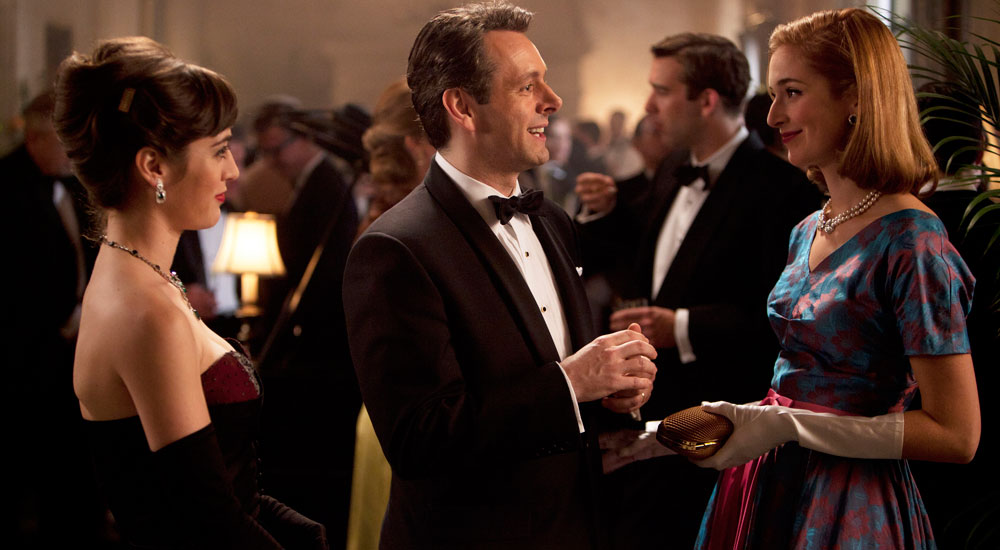
This undated publicity photo released by Showtime shows, from left, Lizzy Caplan, as Virginia Johnson, Michael Sheen as Dr. William Masters and Caitlin Fitzgerald as Libby Masters in the pilot for “Masters of Sex.” AP Photo/Showtime, Craig Blankenhorn
LOS ANGELES – Dr. William Masters was not a feminist. Apart from his studies of the human physiology of sex, he was a traditional man in the mid-1950s, the kind who kept his wife at home.
But his groundbreaking research with Virginia Johnson made him something of a hero for women: A scientific advocate of female sexuality who proved that women were dynamic sexual creatures, perhaps even more so than men.
“Masters of Sex,” which premieres Sunday on Showtime, explores the relationship between Masters (Michael Sheen) and Johnson (Lizzy Caplan) and highlights their pioneering work, which helped fuel the sexual revolution and the women’s movement.
“I see him as a feminist hero,” Caplan said, “and that’s certainly not what he was setting out to do.”
“It was not deliberate on anyone’s part,” executive producer Michelle Ashford said of the feminist nature of Masters and Johnson’s work.
“They ended up really championing women, but that was because they were basing it on the science that they saw… They realized women were robust sexual creatures, and in fact, in many ways they were more robust than men. So this was not an agenda of theirs in any way. It just emerged naturally out of the data that they were collecting.”
Masters was a gynecologist who began his research with Johnson in 1956 so he could better help his patients overcome their sexual problems. He and Johnson not only interviewed their subjects, they measured physiological responses to sex by observing them masturbating and having intercourse.
Capturing this aspect of Masters and Johnson’s work proved blush-worthy for the show’s cast and crew.
“It’s very hard not to notice when someone is masturbating with a glass dildo in front of you,” Sheen said. “But as time went on, it was quite extraordinary how quickly (we) got used to that.”
Sheen knew very little about Masters before signing on to the role, but found the doctor’s accidental feminism the most compelling aspect of his character. Masters was a regular church-goer, politically conservative, and a typical man of his time in his relations with women.
“He was fairly typical, and yet the work that he did played a part in creating a whole new era of female sexuality and gender politics,” Sheen said. “It was quite surprising that his work was so progressive and led to so many changes that we’re still living through, in terms of how women are perceived in our society and in our culture, and yet he was even more than typical — he was quite extreme in how he personally dealt with women.”
Caplan was also unfamiliar with the pair’s work, but leapt at the chance to play an unconventional woman like Johnson, a twice-divorced single mother who felt that sex and love didn’t necessarily have to go together. She started out as Masters’ secretary but quickly became his partner, first professionally, then romantically.
Sharing Masters and Johnson’s research with a modern TV audience “is part of the reason why doing the show is so exciting,” Caplan said, adding that she has long considered herself a feminist.
“It never crossed my mind that before they knew the science of the female orgasm that it could be something that held women down in society,” she said.
Masters and Johnson’s research disproved the prevailing Freudian theories of the time that blamed women for most sexual dysfunction (i.e. penis envy) and that “mature” female orgasms necessitated a male partner’s participation.
“(They) debunked that idea, and certainly in so doing supported feminist notions about, literally, women doing it for themselves,” said executive producer Sarah Timberman.
But it’s not like the show comes off as a stuffy science lecture. Set in a St. Louis research hospital (replicated on a Sony soundstage), “Masters of Sex” is a trip through the 1950s aesthetically and culturally. The ’50s fashions and furniture (and pharmaceutical bottles) take viewers back in time, and may have spawned some “Mad Men” comparisons in the press.
Producers maintain that “Masters” is very different: It’s a look at two real people whose research changed the way we think and talk about sex and remains relevant and revelatory today.
“They were trying to take something that’s so fundamental to the human experience and bring it into the light and out of the shadows. And the weirdness surrounding some of our discussions on the show just shows you that, here we are 50 years later, and we’re not that different than we were,” Timberman said.
“In many ways we’ve advanced, but in many ways we’re still the same fumbling, confused people we were when Masters and Johnson were doing their work.”